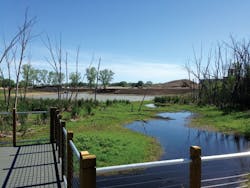Storm Water Management: Eyesore to Amenity
Sustainable storm water management is more than just a vision in one Wisconsin city—it is a reality. The city of Oak Creek, Wis., along with Milwaukee Metropolitan Sewerage District (MMSD), Wispark LLC and GRAEF collectively transformed a dilapidated manufacturing brownfield into a thriving town square.
The 86-acre Drexel Town Square site contained a demolished manufacturing facility and was an eyesore to the community of approximately 35,000 people in southeastern Wisconsin. Bounded by two major streets and located in the middle of a developing area, the site was prime property for rehabilitation. Drexel Avenue bounds the site to the north and became the namesake for the site. The Wisconsin Department of Transportation added exit ramps from Interstate 94 to Drexel Avenue, bringing increased visibility to the site.
With this visibility and the ongoing economic development in the vicinity, the city and developer were motivated to turn the dilapidated site into an amenity for the community, featuring retail, office, restaurant and public use facilities. MMSD also was motivated to direct the site runoff to sustainable storm water features and became a critical collaborator in the development process.
A Team & a Plan
The stakeholders joined forces with architects and construction managers in addition to the engineering, landscape architecture and urban planning teams at GRAEF. Together, the team analyzed and developed a new concept for the town square. The plan included restoration of existing wetlands and systems exceeding local storm water management requirements, and the incorporation of green infrastructure throughout. It also took into account the functionality of a thriving town square. Buried foundations and debris from the former manufacturing facility complicated the concept, as did existing wetlands and elevation changes toward the future storm water treatment area. Further complicating the plan was the need to complete the development in phases, with public infrastructure coming first.
The baseline storm water management requirements included storm water quantity and quality regulations. Post-construction peak discharge for a two-year event could not exceed 0.15 cu ft per second (cfs) per acre of development, and for a 100-year event could not exceed 0.4 cfs per acre. Storm water BMPs were required to reduce the total suspended solids (TSS) by 80% as compared to no storm water controls. The project team took those requirements a step further and created additional site-specific goals. It set out to store all storm water on site for a 100-year storm event, treat all storm water from parking lots, infiltrate and recharge the groundwater table, and restore the ecology of the existing wetlands.
The buried foundations and debris posed some constructability challenges and required adjustments to the storm water management plan to avoid excavation expenses. More than $1.3 million was spent on brownfield remediation and foundation removals.
Implementation & Construction
Demolition of the existing buildings, mass grading and large-scale storm water management were among the first phases of the construction process. Smaller-scale storm water management features within the right-of-way of the new city streets followed shortly thereafter. Completion of the wetland restoration during this phase created the park amenity for the project. Future developments include storm water management requirements within the developer’s agreements to maintain the intent of the concept plans and meet the overall project goals.
The team worked through the design challenges and successfully exceeded the storm water management requirements and site-specific goals. Storm water BMPs included wet detention ponds, a dry detention pond, storm water trees, biofiltration basins and porous pavement.
Ultimately, the project redirects and provides storage for all storm water up to a 100-year storm event, and exceeds the city of Oak Creek and MMSD peak flow criteria by more than 60%. TSS from site runoff was reduced by more than 80%. Storm water was directed to areas of pervious pavement, biofiltration devices and storm water trees to promote infiltration and groundwater recharge. The 35-acre wetland park was enhanced to become a site feature to draw city residents back to nature. It includes walking paths and observation areas with natural scenic views.
Planning for the Future
As part of developing the concept plan and sustainable storm water solutions, the team also developed a sustainable development guidebook, a new tool for evaluating the most appropriate BMPs for projects throughout the MMSD jurisdictional area. The guidebook includes BMPs to address post-construction options, such as supportive, onsite monitoring and maintenance.
MMSD provided a grant to Oak Creek to implement sustainable BMP features on projects throughout the city. This grant allowed the project team to implement BMPs that otherwise would not have been economically feasible.
More than $180 million of development is expected to fill the Drexel Town Square with more than 300,000 sq ft of mixed commercial and retail space; 230,000 sq ft of restaurant space; 450,000 sq ft of residential space; 60,000 sq ft of public facilities; and associated parking. The first developments in the town square were a city hall and library, Water Street Brewery and a Meijer grocery store.
The former brownfield has become a hot spot for development in the metropolitan Milwaukee region, proving successful storm water management and green infrastructure can go hand-in-hand with brownfield redevelopment. The Drexel Town Square is on its way to becoming a true amenity for the city of Oak Creek and its residents.
Download: Here


